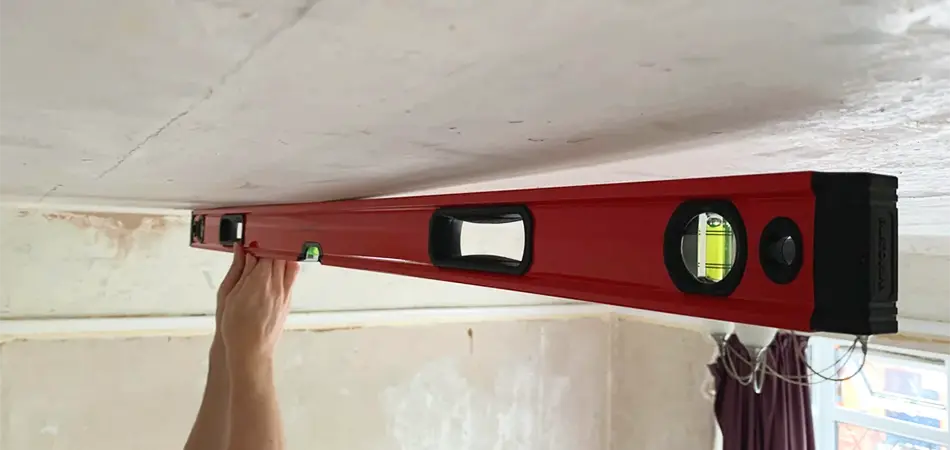
Sagging ceiling causes are often linked to the plasterboard detaching from the ceiling joists. While this sagging isn’t classified as a major structural defect, it can still pose a serious issue and a safety hazard in any home.
Many homeowners face this problem, which typically occurs when the plasterboard loses its attachment to the ceiling joists. Over time, this can cause the ceiling to droop or sag, creating an uneven surface that can potentially become dangerous.
Understanding Sagging Ceiling Causes and Risks
A sagging ceiling can be more than just an eyesore. It can become a serious safety concern. If the ceiling continues to sag, it could eventually collapse. This poses a risk of injury to anyone in the room (or even death). Falling plasterboard can also damage furniture and other belongings.
Additionally, a sagging ceiling may indicate other underlying issues. These could include water damage or structural problems. Addressing the issue early can prevent more significant damage and costly repairs.
Sagging Ceiling Causes
Several factors can cause a ceiling to sag, and it’s essential to understand each one to address the issue effectively.
1. Building Age
Sagging ceiling causes can often be traced to ageing materials and weakened adhesives. As a building ages, these components degrade, leading to movement and eventual sagging in the ceiling. While this is common in older homes, even newer properties can experience cracks and sags as they settle during the first few years. Regular inspections are essential to identify and address these issues early before they become more serious.
2. Roof Leaks
Water damage from a leaking roof can be a significant problem for ceilings. When water seeps into insulation, it adds considerable weight to the ceiling plasterboard. This extra weight can cause the ceiling to sag and potentially collapse. If you notice mould or stains on your ceiling, it might indicate a roof leak. Addressing roof leaks promptly is essential to prevent further damage.
3. Mold and Mildew
Roof leaks often lead to water-damaged ceilings, which further lead to mould and mildew. And they also happen in humid climates or poorly insulated homes. Mould and mildew can weaken the ceiling structure and lead to sagging. It’s essential to have the ceiling tested and treated by a professional if mould or mildew is suspected.
4. Sagging Ceiling Causes: Building Structural Movement
Buildings can shift and move due to changes in temperature. As the foundation or frame expands and contracts, materials like plasterboard and ceiling cornices also move. These small shifts are common sagging ceiling causes, leading to warping, stretching, cracking, and eventually sagging of the ceiling. It’s important to have your building inspected by an expert to identify hidden weak spots and fix existing issues promptly.
5. Inadequate Support
Poor construction or inadequate support for the ceiling can also cause sagging. If the ceiling lacks proper wall or beam support, it is more likely to sag over time. In such cases, a professional inspection can determine the best way to reinforce the structure and prevent further sagging.
6. Termites and White Ants
Termites and white ants can cause severe structural damage to your home, including the ceiling. They can destroy load-bearing timber structures, leading to sagging, cracks, or even collapse. Signs of termite damage include water stains, sagging, termite frass, and mud tubes on external walls. Regular termite inspections and preventative measures can help protect your home.
7. Vibrations from Roller Doors
Garage ceilings often experience more vibrations than other areas of the home. Power-operated roller doors can create sharp, repetitive movements that stress the ceiling. Over time, these vibrations can cause the ceiling to crack, warp, or sag. It’s best to have an expert assess any ceiling damage caused by vibrations to prevent more significant problems.
Regularly inspecting your ceiling for signs of sagging, such as cracks, stains, or bowing, can help you catch problems early and address them before they become more serious.

How to Identify Sagging Ceiling Issue
Sagging ceiling causes can be identified through several visible signs. Identifying a sagging ceiling is relatively straightforward. Here are some key signs to look for:
1. Noticeable Sag or Dip
The most obvious indicator is a visible sag or dip in the ceiling. This can often be seen from the ground, but sometimes, you might need to climb a ladder for a closer inspection.
2. Cracks and Gaps
Look for cracks in the ceiling or gaps between the ceiling and the walls. These can indicate that the ceiling is beginning to sag or separate from the walls around the cornice.
3. Pronounced ‘V’ Shape
A pronounced ‘V’ shape where plasterboard sheets meet or join is another sign. This can happen when the fixings in the centre of the plasterboard sheets give way, causing the sheets to droop.

4. Ceiling Separation
In some cases, you may notice the ceiling separating from the walls around the cornice. This separation can be a clear indicator of a sagging issue.
While sagging ceilings are often non-structural and can usually be repaired relatively easily, it’s crucial to have a professional building inspector check your ceiling. They can determine the cause of the sagging and assess whether it poses any risk to you and your home.
Dealing with Sagging Ceilings
Sagging ceiling causes should be professionally assessed as soon as they’re identified. If you’ve noticed a sagging ceiling in your home, the first step is to have it inspected by a qualified building inspector. They will determine the exact cause of the sagging and recommend the best course of action. Repairing the ceiling may involve reinforcing the joists or adding additional support. In some cases, the entire ceiling might need to be replaced.
It’s crucial to work with a licensed and experienced contractor who can identify the root cause, provide a detailed estimate for the repairs, and ensure that the work is done safely and to a high standard.
Expert Solutions for Sagging Ceilings
If you’re facing the issue of a drooping ceiling, don’t wait! Contact Perth Ceiling and Walls for sagging ceiling repair. Our team of experienced professionals has the skills and knowledge to identify the root cause of your drooping ceiling and provide a solution to the problem.
As a trusted Perth ceiling fixer, we use only the highest-quality materials and techniques to ensure that your ceiling is repaired properly and securely. Don’t let a drooping ceiling bring down the beauty and safety of your home.
Contact Perth Ceiling and Walls today and get the peace of mind that comes with a stable, secure ceiling.
Reviewed by
Aaron Kumar
Aaron Jefferson Kumar. The owner and operator of Perth Ceiling and Walls. With hands-on expertise in plasterboard ceiling and wall repairs and installations, Aaron takes pride in ensuring every project meets the highest standards of quality and craftsmanship. His direct involvement in both the business and the fieldwork positions him as a trusted person on all things related to ceiling and wall solutions.
